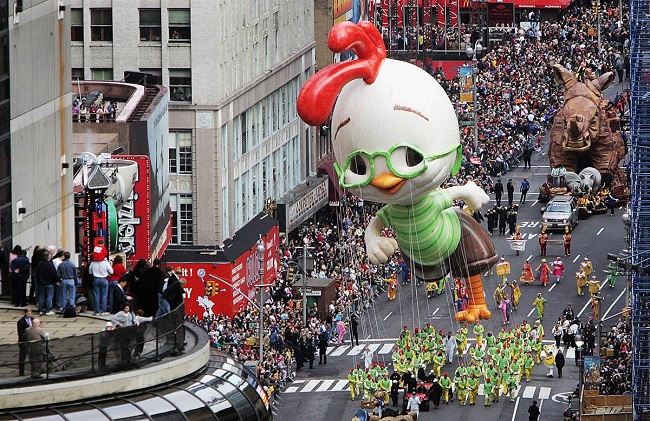Every year on the 4th Thursday of November, a day opens with an annual procession that wows the crowd with festive entertainment, Disney characters, fancy floats, giant balloons, and musical band marching through the streets of different cities in America.
Apart from a political rally where people chant slogans — it’s a long followed tradition that signifies a symbol of peace and love, bringing people of every background to parade and celebrate together, singing and dancing a song of unity in perfect harmony, and thanking God for his many blessings.
It’s a festive Day of Thanksgiving!
In 2019, this special 4th Thursday of the year falls on November 28.
Short History Of Thanksgiving Parade
Thanksgiving parade has a century of history.

Chicken Little debuting on the Thanksgiving Parade in 2004 (©: today.com)
The first parade ever staged was in Philadelphia, in 1920, when more than 50 costume-dressed employees of Gimbels Department Stores marched down the market featuring floats, before introducing Santa Claus in the finale. That marked the beginning of a tradition of the parade.
Then it was followed by New York City in 1924, as the employees of another department store Macy dressed in vibrant costumes and marched down to the flagship store on 34th street.
The parade used floats and featured live animals like monkeys, bears, camels, and elephants, which all borrowed from the Central Park Zoo.
Introducing huge balloons in 1927, the parade — originally called Macy’s Christmas Parade — was renamed as Macy’s Thanksgiving Parade.
Plymouth Rock
The parade is just a part of the ritual —Thanksgiving is the main festival.
The history of the Thanksgiving trend could be traced back to nearly four hundred years ago in the colonial period. It was a cold winter of the year 1620 as a group of English colonists (pilgrims) explored the land of Plymouth, Massachusetts, and began setting up the settlement. Finally, a long hard winter passed, and spring came, and they went to socialize with a local Wampanoag people without incident and succeed in making a bountiful harvest in the autumn of 1621.
ALSO DISCOVER ON: History Of Veterans Day, Meaning, Origin, Facts, Vs Memorial Day
As a part of the celebration, a harvest feast was shared between the English colonists and the Wampanoag indigenous locals in Plymouth, Massachusetts, that was regarded as one of the first Thanksgiving celebrations.
The tradition continued ever since.
And there still stands a famous Plymouth Rock — inscribed with 1620. Some said it’s just a myth that the pilgrims didn’t land on any specific rock, but folklore insists they did.
Foods, Outfits, And Events
Everyone knows ‘Thanksgiving’ is known for its cuisine.
As the notion of Thanksgiving came after a feast was shared between the pilgrims and Wampanoag people, we don’t know the exact menu of that event and the recipes they followed. Still, it’s believed that a meal included fowl, and probably fish, eels, shellfish, stews, vegetables, and beer. So, foods are the roots and an inevitable part of the Thanksgiving Culture.
Turkey, Stuffing, Cranberries, Mashed potatoes, Gravy, Corn, Sweet potatoes, Green bean casserole, and Pumpkin pie are the names of common dishes that are synonymous with Thanksgiving. Such recipes with a list of ingredients are available in Delish.
Based on the colors of foods, there are five thanksgiving colors. Orange is a pumpkin, Yellow for the corn, Brown is the turkey, Reds are the cranberries, and Green are the beans.
Food and the colors of outfits complement each other.
We’re celebrating Thanksgiving Day in the modern world of 2019. So outfit becomes an inescapable impression that everyone thinks about, where people during the week, have to attend full of live events like parades, parties, concerts, NFL football matches, and other festive entertainment.
Facts And Trivia
# Thomas Jefferson, Abraham Lincoln, and Franklin Delano Roosevelt
These are the names of three presidents, who’re still remembered on Thanksgiving Day for different reasons.
Thomas Jefferson, who served as the third president of the United States, famously refused to declare a thanksgiving day, calling the holiday as ‘a ridiculous idea ever conceived.’ He strongly believed in the ‘separation of Church and State,’ and endorsing such celebrations as president would mount state-sponsored religious worship.
On 3 October 1863, the first official proclamation came — after the years of campaigning to promote unity by an activist, editor, and author, Sarah Josepha Hale — when President Abraham Lincoln called thanksgiving a national holiday that it was officially scheduled to fall on the fourth Thursday of every November.
And Franklin D. Roosevelt tried something exception. With a concern to extend the Christmas shopping season that was cut short by a late thanksgiving, he thought it would also lift the economy during the Great Depression.
He changed the date back a week earlier, to the third week in November, and decreed in 1939, but was decried by his political opponents and thanksgiving traditionalists, referring it ‘Franksgiving.’
It made such a public outcry that Congress reinstated the date, moving back to the fourth Thursday, in which Roosevelt proclaimed in 1942.
# It’s Turkey Day For Americans
No Thanksgiving meal is as completely defined without the presence of turkey!
Since it’s the nation’s favorite bird, it has embraced the American art of culinary.
Once, Benjamin Franklin wanted the turkey to be the official bird of the United States.
Happy Thanksgiving Day!

